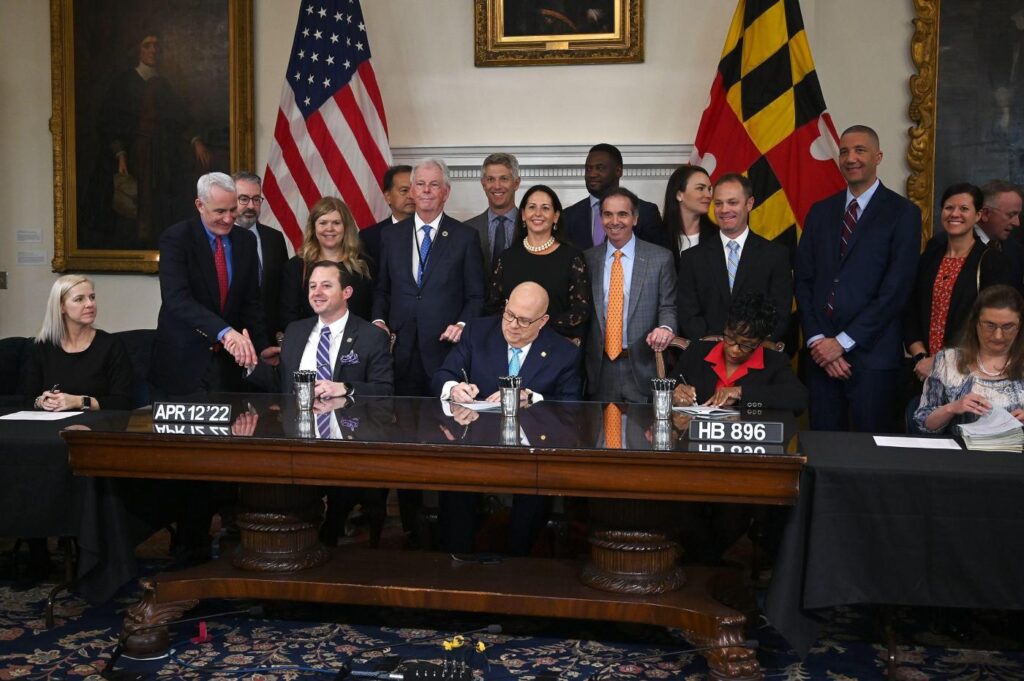
Gov. Larry Hogan signed legislation Tuesday that could help secure long-term commitments from the Orioles and Ravens to remain in their current Baltimore stadiums, allowing the Maryland Stadium Authority to borrow up to $1.2 billion for upgrades to the decades-old structures.
The Ravens have five years left on their lease at M&T Bank Stadium, while the Orioles’ original lease for Oriole Park at Camden Yards, which opened to great fanfare in 1992, was set to expire last year but then extended another two years. Specific improvements to the stadiums have not been determined, but the investment could help advance ongoing negotiations for new long-term leases.
“The money is most critical from a standpoint of being able to extend the useful lives of these stadiums,” said Thomas Kelso, chairman of the Maryland Stadium Authority. “The way this bill was designed and this funding was designed is really to foster this idea of a partnership with both teams.”
The legislation increases the allowable bond debt for stadium projects from $235 million to $1.2 billion, and would require the teams to sign leases at least as long as it takes to pay off the bonds, which is done with state lottery proceeds. Up to $600 million in outstanding debt would be allowed for projects at each club’s stadium at any given time.
Another piece of legislation signed Tuesday by Hogan and top Democratic leaders of the General Assembly will create a $200 million fund to improve minor-league parks and other sports facilities around the state, as well as invest $400 million in development around FedEx Field, the current Prince George’s County home of the NFL’s Washington Commanders, though none of that money will go toward improvements to the stadium itself.
The Commanders are contractually obligated to remain at FedEx Field in Landover through 2027, although the team’s owners have discussed possible moves to the District of Columbia or Northern Virginia.
John Angelos, chairman and CEO of the Orioles, hailed the public investment on Monday in a lengthy statement released by the team, calling it the “second-largest public commitment of funding to a Major League Baseball public-private sports partnership, second only to the 2009 construction of the new Yankee Stadium.”
Angelos touted progress for the struggling Orioles baseball franchise, which has finished at or near the bottom of the American League standings in each of the past five seasons. He said the stadium has made strides toward becoming a more inviting venue for baseball and other events, noting a performance by Billy Joel and an upcoming Paul McCartney show, while continuing to offer “family-friendly pricing, atmosphere and customer service and satisfaction.”
The legislation also provides another $10 million in public funding to pursue large-scale sports or entertainment events, such as Major League Baseball’s All-Star game, or World Cup soccer games. It also will fund studies on efforts to redevelop two horse-racing venues: Baltimore’s Pimlico Race Course, which hosts the annual Preakness Stakes, and Laurel Park.
The bill-signing ceremony on Tuesday at the State House in Annapolis came hours after the General Assembly wrapped up its 90-day legislative session at midnight Monday. The governor is set to sign another batch of bills next week, with several more signing ceremonies typically scheduled in April and May. Lawmakers have 20 days post-session to present passed legislation to the governor. He then has 30 days to veto or sign it, or it becomes law without his signature.
Other bills in the stack Hogan signed Tuesday included a measure to make Juneteenth a permanent state holiday, and another marking the fourth Thursday in March as Tuskegee Airmen Commemoration Day in honor of the country’s first Black military aviators, who fought with distinction in World War II.
Hogan likewise signed a measure to create a public investment board aimed at attracting jobs to Western Maryland and bolstering the economy there, and another to make Peace Corps volunteers eligible for in-state tuition at the state’s public colleges and universities.
The stadium investment bill, Kelso said, means that while many ballparks become obsolete after 30 years, Oriole Park is poised at that age to remain what the team calls the park that changed baseball for far longer. He pointed to the oldest and most storied parks in baseball, Wrigley Field in Chicago and Fenway Park in Boston, as examples for what the future could hold for Camden Yards if it is kept up properly.
“People talk about Oriole Park in the same breath as they talk about those two stadiums,” Kelso said.
For the Ravens, there isn’t a similar mold of a classic football stadium to follow, Kelso added. But he said the sort of investment the legislation allows could add another 25 to 30 years to the life of a stadium that opened in 1998, two years after the Browns moved to town from Cleveland and took on the Ravens moniker.
In an interview with The Baltimore Sun, Ravens owner Steve Bisciotti recently called the stadium bond legislation “comforting,” and something that could help inspire a vision for the team at M&T for decades to come.
“I’m really happy to hear that the money is there to be allocated, to figure it out,” he said. “I would sell the team before I’d get into a threat to move the team.”
What specific upgrades the investment allows for will be up to the teams to suggest, Kelso said. After that, the stadium authority would help plan, engineer and construct the new stadium features.
“It’s the teams that are interacting with the fans,” he said. “It’s really the teams determining what is necessary.”
Baltimore Sun reporter Jonas Shaffer contributed to this article.
()
